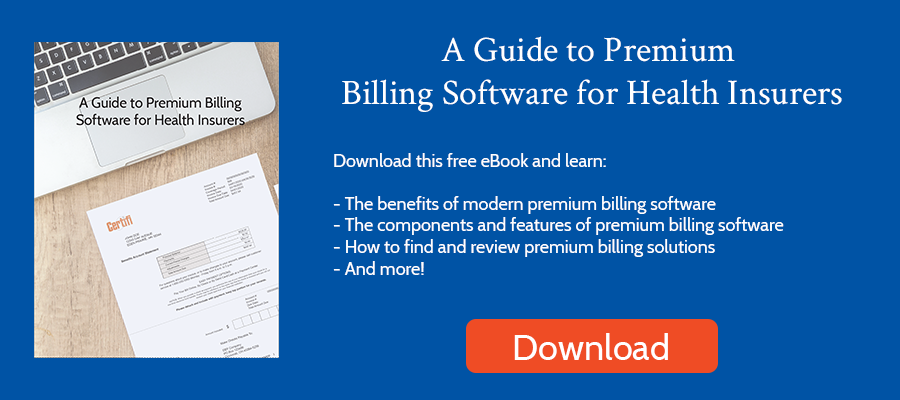Premium billing software is essential to managing billing operations. The benefits of premium billing software are obvious: reduced billing costs, improved on-time payment rates, streamlined billing processes, and an improved member and customer experience.
The Future of Premium Billing Software
-
- Automation
- Componentization
- Cloud-based
- Integration
Demand for premium billing software will continue to rise due to those benefits. As a result, the software will continue to evolve. Here’s a look at what the future of premium billing software will look like:
Automation
Premium billing software can automate low-level tasks, freeing employees for higher-value work. That means automating routine tasks like generating invoices, collecting payments via a payment portal or autopay, and automating remittance generation and delivery.
However, there are additional automation opportunities that will enhance premium billing software in the future, including:
- Automated Reconciliation – For health plans that also serve as a Medicaid managed care organization, reconciling capitated payments they’ve received from the state can be a manual, error-prone process. Premium billing solutions can receive enrollment data to calculate expected payments, then compare expected to payments received. The health plan can identify underpayments, missed payments, and more, then submit that information to the state for reimbursement. The general ledger can also receive that data.
- Automated Payment Application – Our solution uses machine learning and AI to automate the manual research performed to apply checks lacking payment stubs. That process typically involves training a machine to read a check payment, identify relevant information, and then access a database to determine which account is most likely to have made the payment. A human then reviews that recommendation and applies the check to the appropriate account. The software learns from that application to improve over time. This process eliminates manual work, enabling customers to process as many as four times as many checks in a given period.
- Enrollment Data Normalization – Because incorrect enrollment data can lead to inaccurate invoices, billing vendors must perform enrollment data quality checks. Vendors can leverage machine learning to perform these checks, identifying potentially erroneous data and improving billing accuracy.
Componentization
In component-based solutions, each component performs a specific function. Thanks to modular and self-contained software with well-designed integration interfaces, organizations combine multiple products to create a complete solution. That results in a feature-rich solution that’s flexible and scalable.
In the past, organizations buying premium billing solutions, like health insurers, purchased software bundled with other functionality, like claims administration. Those disparate processes led to less robust billing functionality because vendors that built claims administration solutions weren’t billing experts.
More health plans are taking a componentized approach as they replace these bloated, on-premise solutions piece by piece. As a result, modular billing platforms will become the norm.
Cloud-based Solutions
Cloud-based premium billing software offers benefits that on-premise solutions struggle to match. Among them:
- Scalability: Cloud solutions enable vendors to add computing power dynamically. For billing applications, this is especially important because processing power is needed during specific periods – like when generating invoices. Being able to scale computing resources drives down invoice generation times.
- Cost-effectiveness: The ability to scale up and down processing resources as needed leads to more cost-effective solutions. Cloud providers bill for resources used. Adding and removing resources based on demand is much more cost-effective than building an on-premise server farm.
- Innovation Speed: Cloud software enables providers to release new features quickly, without client intervention. As a result, you’ll get innovative features faster without involving IT staff.
Add it up, and cloud-based solutions will overtake on-premise solutions in popularity soon.
Integration With Other Systems
The key to successful componentized software design is interoperability. Premium billing software that can integrate with other systems like enrollment products, claims administration solutions and accounting software will gain popularity in the future.
Software uses several integration methods. However, most modern applications leverage application programming interfaces (APIs). Simply put, APIs enable an application to utilize the functionality or services of another application by making specific API requests. For billing solutions, that means an API that enables other applications, like a member portal, to access billing-related data, including amounts due, historical invoice data, and more.
Other integration methods include single sign-on (SSO) and file exchanges. SSO integrations enable user permissions to be inherited from one application to another, simplifying permission management. File exchanges pass data between software solutions via a file and can be automated to reduce manual intervention.
Overall, the future of premium billing software is likely to be shaped by automation, cloud-based solutions, integration with other systems, and componentization.
Certifi’s health insurance premium billing and payment solutions help healthcare payers improve member satisfaction while reducing administrative costs.



